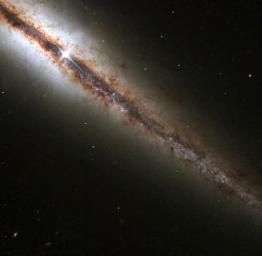An amazing "edge-on" view of a spiral galaxy 55 million light years from Earth has been captured by the Hubble Space Telescope. The image, available at http://hubblesite.org/newscenter/archive/releases/2001/07/image/a/, reveals in great detail huge clouds of dust and gas extending along and above the galaxy's main disk.
The image was taken by Hubble's Wide Field and Planetary Camera 2, which was designed and built by NASA's Jet Propulsion Laboratory, Pasadena, Calif.
The galaxy, called NGC 4013, lies in the direction of the constellation Ursa Major. If we could see it pole-on, it would look like a nearly circular pinwheel. In this Hubble image, NGC 4013 is seen edge-on, from our vantage point. Because the galaxy is larger than Hubble's field of view, the image shows only a little more than half the object, but with unprecedented detail.
Dark clouds of interstellar dust stand out, since they absorb the light of background stars. Most of the clouds lie in the galaxy's plane and form the dark band, about 500 light years thick, that appears to cut the galaxy in two from upper right to lower left. Scientists believe that new stars form in dark interstellar clouds. NGC 4013 shows several examples of these stellar kindergartens near the center of the image, in front of the dark band along the galaxy's equator. One extremely bright star near the upper left corner is merely a nearby foreground star that lies in our Milky Way and happened to be in the line of sight.
This new picture was constructed from Hubble images taken in January 2000 by Dr. J. Christopher Howk of Johns Hopkins University, Baltimore, Md., and Dr. Blair D. Savage of the University of Wisconsin-Madison. Images taken through three different filters have been combined into a color composite covering the region of the galaxy nucleus (behind the bright foreground star at the upper left) and extending along one edge of the galaxy to the lower right.
The Space Telescope Science Institute, Baltimore, Md., manages space operations for the Hubble Space Telescope for NASA's Office of Space Science, Washington, D.C. The Institute is operated by the Association of Universities for Research in Astronomy Inc., for NASA under contract with NASA's Goddard Space Flight Center, Greenbelt, Md. The Hubble Space Telescope is a project of international cooperation between NASA and the European Space Agency. JPL is a division of the California Institute of Technology in Pasadena.
Additional information about the Hubble Space Telescope is available at http://www.stsci.edu/hst/. More information about the Wide Field and Planetary Camera 2 is available at http://www.stsci.edu/hst/wfpc2.

 Planetary Data System
Planetary Data System












